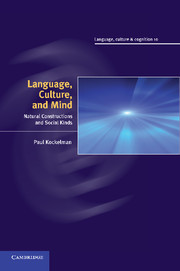Book contents
- Frontmatter
- Contents
- List of illustrations
- Acknowledgements
- 1 Language, culture, mind: emblems of the status human
- 2 Inalienable possessions: what hearts, mothers, and shadows have in common
- 3 Interclausal relations: how to enclose a mind by disclosing a sign
- 4 Myths about time and theories of mind: why the moon married the sun
- 5 Other minds and possible worlds: when psychological depth is dialogical breadth
- 6 Interjections: why the centre of emotion is at the edge of language
- 7 Conclusion: natural constructions and social kinds
- Appendix A Transcription conventions
- Appendix B The Marriage between the Sun and the Moon
- References
- Index
7 - Conclusion: natural constructions and social kinds
Published online by Cambridge University Press: 04 May 2010
- Frontmatter
- Contents
- List of illustrations
- Acknowledgements
- 1 Language, culture, mind: emblems of the status human
- 2 Inalienable possessions: what hearts, mothers, and shadows have in common
- 3 Interclausal relations: how to enclose a mind by disclosing a sign
- 4 Myths about time and theories of mind: why the moon married the sun
- 5 Other minds and possible worlds: when psychological depth is dialogical breadth
- 6 Interjections: why the centre of emotion is at the edge of language
- 7 Conclusion: natural constructions and social kinds
- Appendix A Transcription conventions
- Appendix B The Marriage between the Sun and the Moon
- References
- Index
Summary
Methodology as theory
As implicit in the foregoing chapters, a key methodological assumption of this monograph is that analysis must take into account relations between relations. This phrase is borrowed from Evans-Pritchard (1940: 266), who concluded his seminal study of Nuer social structure by reference to it. For present purposes, it means that analysis should not only privilege relations over relata, it should also privilege relations between relata that are themselves relations. While this is a relatively abstract idea, it is central to any comparative project, and has undergirded the analysis undertaken in each chapter. It is best explained by demonstrating the variety of uses to which it has been put, all of which were a means to resolve the questions, concerns, and conundrums introduced in chapter 1.
A key class of grammatical constructions that were examined involves complement-taking predicates, such as she believes he is rich, I want to call him, and Dave heard that she had been injured. Generalizing some concepts and terms from Jakobson (1990a), such constructions may be understood as involving three events: the speech event (e.g. the event of communicating beliefs, desires, and perceptions); the mode event (e.g. the event of believing, desiring, or perceiving); and the content event (e.g. the event believed, desired, or perceived). By using grammatical categories such as person, tense, deixis, status, and evidentiality, the mode event may be displaced from the speech event, and the content event may be displaced from the mode event.
- Type
- Chapter
- Information
- Language, Culture, and MindNatural Constructions and Social Kinds, pp. 202 - 208Publisher: Cambridge University PressPrint publication year: 2010



